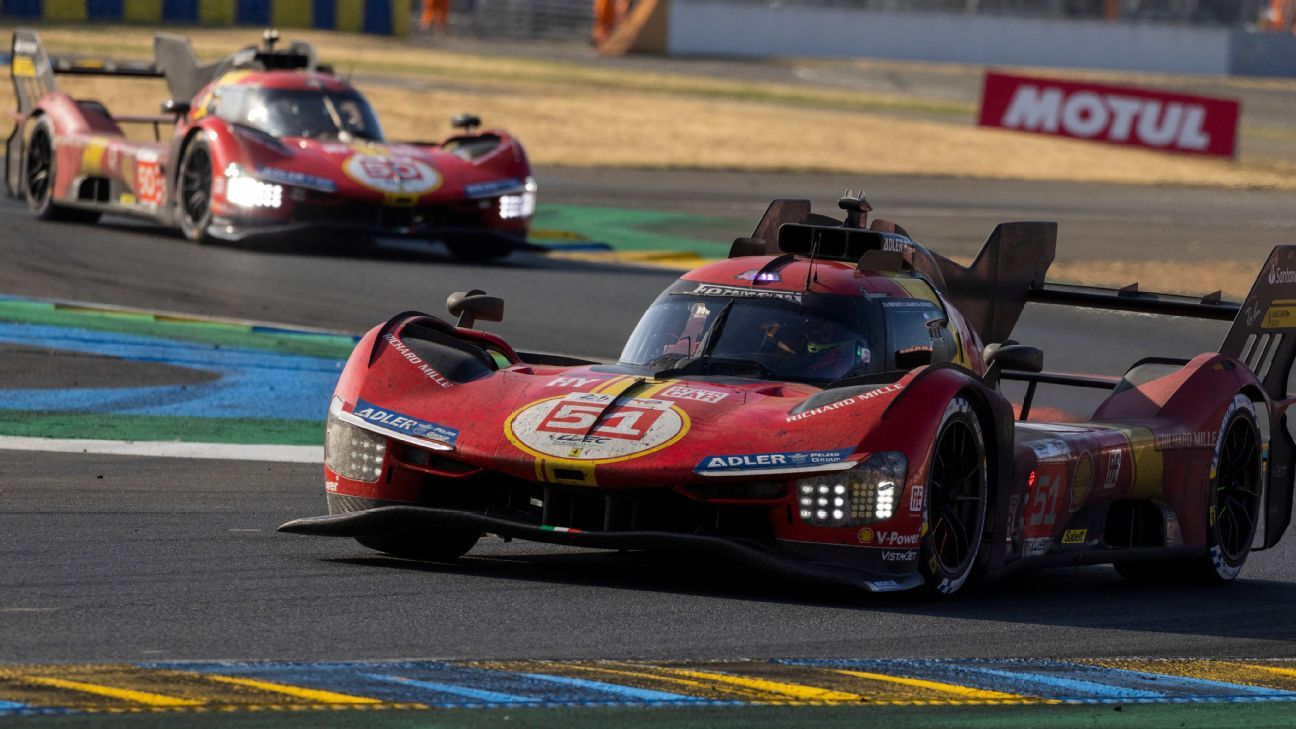Ferrari returns with victory in Le Mans centennial

ESPN News Services
Jun 11, 2023, 10:43 AM ET
Ferrari ended a 50-year absence from the 24 Hours of Le Mans by toppling mighty Toyota on Sunday in the centenary running of the most iconic sports car race in the world.
Ferrari last competed at Le Mans in 1973 but returned to Circuit de la Sarthe this year as part of a new hyperclass category that features hybrid technology.
The hyperclass came from a rules convergence that allowed competitors from the United States’ sports car series, IMSA, to compete at Le Mans and created an enticing platform automakers viewed as an opportunity to showcase their street car technology.
1 Related
Ferrari developed its program — a two-car effort that competes in the World Endurance Championship — over several years in a strategy similar to what was depicted in “Ford v Ferrari,” the 2019 film that focused on the boardroom pressures and drama surrounding Ford’s 1963 successful effort to end Ferrari’s reign at Le Mans.
Only this time it was Ferrari trying to knock down a giant: the two-car Toyota Gazoo effort, which had entered the twice-round-the-clock race on a five-year winning streak.
Toyota was dealt a blow before the race even began when race officials this week added weight to the dominant GR010s in a controversial “balance of performance” adjustment designed to level the playing field.
Ferrari, in a pair of 499Ps, pounced, sweeping the front row in qualifying and handling every challenge from Toyota. Its chances were aided overnight when Kamui Kobayashi was wrecked out of the race, making it two versus one in favor of Ferrari.
The team of Alessandro Pier Guidi, James Calado and Antonio Giovinazzi — with Ferrari Formula One driver Charles Leclerc in the garage watching — was the easy winner while completing 342 laps of the 8.467-mile track, the fewest by the victor since 2001.
“It’s emotional. Unbelievable. I have no words,” Giovinazzi, a former F1 driver, told Eurosport television.
Said Calado: “It’s a great achievement, and after so long, I think this one will go down in history for sure.”
The trio had a solid lead even before defending race winner Ry? Hirakawa locked the brakes on his Toyota and hit the wall with 1 hour, 44 minutes remaining.
It took roughly three minutes for repairs to the car, not enough time to help Chip Ganassi Racing, which carried the American flag at Le Mans for IMSA.
The centenary marked the first year IMSA’s top class was granted participation at Le Mans, and the new hyperclass brought Cadillac back to both IMSA and WEC with Ganassi, same for Porsche with Roger Penske in the 86-year-old’s attempt to win one of the few races missing on his list. It also brought a slew of new manufacturer interest to sports car racing, which helped draw a sold-out crowd of 300,000-plus spectators.
The Ganassi Cadillacs were running third and fourth when Hirakawa spun, eliminating the defending champions’ chances at a repeat. But it briefly created an opportunity for one or both Cadillacs to improve their finishing position.
Toyota executed flawlessly on its pit stop, and the Cadillacs gained no ground. The WEC team of Earl Bamber, Alex Lynn and Richard Westbrook took the final spot on the podium, with the IMSA team of Sebastien Bourdais, a Le Mans native, Renger van der Zande and Scott Dixon finishing fourth.
Ferrari’s second car finished fifth, one spot ahead of the top-finishing Porsche from Team Penske. His other two 963s both had early retirements.
The third Cadillac, fielded by Action Express Racing out of IMSA, crashed on the first lap and was never in contention. That team is supported by IMSA and NASCAR owner Jim France, who successfully brought a stock car to Le Mans to represent the American series in its 75th anniversary season.
NASCAR last had a presence at Le Mans in 1976 and returned this year with a version of its second-year Next Gen car. The “Garage 56” car was fielded by Hendrick Motorsports, Chevrolet and Goodyear, the winningest team, manufacturer and tire supplier in NASCAR’s 75 years.
The No. 24 Camaro was in a class by itself racing against no other cars. The initial goal was simply to finish the race and showcase NASCAR, but the Chad Knaus-led project was so outstanding that until a brake issue with about five hours remaining, it seemed as though the lineup of seven-time NASCAR champion Jimmie Johnson, 2009 Formula One champion Jenson Button and former Le Mans winner Mike Rockenfeller might actually beat the entire 21-car GTE AM field.
The time to fix the brakes took that off the table, and it felt like a disappointment for all that NASCAR had accomplished. The car had a later issue that required a gear box change, but the engine lasted the distance and the car crossed under the checkered flag for a champagne celebration.
“How’s it feel to take the checkered flag at Le Mans?” team owner Rick Hendrick radioed Johnson as he completed the 285th lap for the Camaro.
“Awesome,” Johnson replied.
The car finished 39th in the 62-car field — good enough for 10th among the GTE cars. The Camaro was second among that class when it had to stop to change its brakes.
“That was thousands of hours of hard work by hundreds of people that went into making this thing happen. And then the way the team and the pit crews and everybody performed all week, it was just fantastic,” France said. “I hope my dad and my brother are somewhere up there looking down and smiling, but the goal when we set out was to try and finish the race running at the end and not be last. And we accomplished that.”
The Associated Press and Reuters contributed to this report.